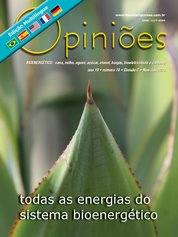Silene Cristina de Lima Paulillo
Research Coordinator in Fermentation and Yeast Selection at Fermentec
OpAA74
Biodiesel production from vinasse
Co-author: Mário Lúcio Lopes, Scientific Director of Fermentec
The production of renewable biofuels is one of the solutions for reducing emissions of gases that cause global warming. And it comes as a sustainable alternative by replacing the use of fossil fuels with renewable ones. Among the main biofuels, we have bioethanol , which is produced from the fermentation of sugarcane or corn must, biomethane, which is produced from the anaerobic digestion of vinasse, and biodiesel.
When we talk about the production of biodiesel, we immediately associate that its production is dependent on fruits, oilseeds or even animal fat. And it is true that the largest biodiesel producers in the world use vegetable oils, mainly palm oil (Indonesia) and soybean oil (Brazil and the United States). This demands arable land, which is often limited by not being able to expand. The production of biodiesel from vinasse, which is a residue from sugarcane-based ethanol-producing distilleries, is not dependent on the production of any plant or animal culture.
Therefore, it does not compete with agricultural areas. It is the use of industrial waste as a raw material for the production of a “noble” product such as biodiesel. This technology was developed by Fermentec in partnership with the University of Minho.
This technology is innovative and uses yeasts that are capable of producing and accumulating fatty acids inside, using, in this case, the organic compounds of vinasse as their source of nutrients. This process reduces biological oxygen demand by up to 80%, removes 94% of mono and dicarboxylic acids (acetic, lactic, oxalic, malic and succinic acid).
These yeasts, in addition to lowering the biological oxygen demand of the vinasse, by consuming some organic acids, also raise the pH of the same, which comes close to neutrality, reducing the polluting and corrosive power of the vinasse and making it ready for use in the production of biomethane, due to the elevation of its pH. Once the yeasts store the oil, the cells are removed so that the lipids can be extracted.
These lipids will be used for the production of biodiesel in transesterification reactions. As in the production of biodiesel based on vegetable oils or animal fat, there is the formation of glycerol in the transesterification reaction. The glycerol formed is considered one of the disadvantages of biodiesel production because it represents about 10% of the crude product, and the market does not always assimilate this large amount of glycerol. However, the glycerol generated in the production of biodiesel from vinasse returns to the reactors with the oleaginous yeasts, because they are avid for glycerol and transform it into lipids again, thus closing the cycle.
When we consider carbon dioxide, we know that, in the production of traditional biodiesel (based on vegetable oils), the balance is not neutral, even with lower emissions when compared to the production of petroleum diesel, because the energy required for the production of fertilizers and locomotion of agricultural machines (irrigation, storage and transport of products).
On the other hand, the balance of carbon dioxide in the biodiesel chain, whose raw material is vinasse from ethanol production, has a highly sustainable potential, since it makes it possible to make better use of carbon and reduce the polluting power of vinasse. In other words, we stopped generating fossil carbon dioxide and improved the efficiency of carbon use, without increasing the use of agricultural area and with less environmental impact.
Vinasse biodiesel production is geared towards the 368 plants across the country, responsible for crushing 585.4 million tons of cane per year, producing 29 million tons of sugar and 27 billion liters of ethanol. These plants also produce, annually, about 335 billion liters of vinasse, whose transport and application in the field has a total cost estimated at 2.29 billion reais per year.
Brazilian mills depend on the consumption of diesel to move a fleet of vehicles used for harvesting and transporting sugarcane, in cultural practices, in transport and in the application of vinasse in the field, representing a consumption of 3 liters of diesel per ton of sugarcane.
This means that the sugar-energy sector consumes 1.76 billion liters of diesel annually, which represents about 3.3% of all national consumption of diesel oil. Many mills depend on a fleet of trucks to transport the vinasse over distances of more than 20 kilometers and which return empty to the mills.
To reduce transport costs, one solution has been the use of concentrators to reduce vinasse volumes. Vinasse is also heavily polluting. Just 1 liter is enough to extinguish the oxygen dissolved in 25,000 liters of running water. This polluting power is mainly given by the composition of organic compounds. The stillage generated in these processes is enough to make these distilleries self-sufficient in diesel.
Traditional biodiesel production processes use vegetable oils and animal fat. But no process on an industrial scale has been used or developed to transform organic compounds, pollutants from sugarcane vinasse into oil and biodiesel. Biodiesel produced from vinasse represents a sustainable fuel solution as it is obtained from industrial waste from 368 Brazilian distilleries.
Vinasse biodiesel can be used to replace petroleum diesel to generate savings, reduce pollutant and greenhouse gas emissions, reduce the environmental impact of the polluting power of vinasse and improve sustainability throughout the sector's production chain. sugarcane . And this is the only process that describes the possibility of producing biodiesel and biomethane (produced by several plants) from the same raw material, vinasse, in addition to reducing their polluting capacity.
Brazil now has a new alternative to increase its biodiesel production, with an economic advantage as it demands lower diesel imports; we would generate more jobs and reduce greenhouse gas emissions. This is a technology where economic benefits are aligned with environmental and social objectives.




